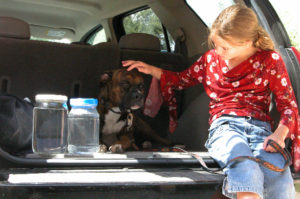Don’t forget to include pets in family emergency, disaster planning
COLLEGE STATION — June is National Pet Preparedness Month, and Texas A&M AgriLife Extension Service experts have some advice on how to keep pets and other animals safe during a disaster or emergency.

“If you need to evacuate your home due to a disaster or other emergency, it’s important to consider what you will do with your pet ahead of that time,” said Dr. Monty Dozier, AgriLife Extension associate professor, College Station. “Whether you decide to stay put in an emergency or evacuate to a safer location, you will need to make plans that include your pets, so integrate a pet emergency plan with your family emergency plan.”
Dozier said an important aspect of preparing a pet for an emergency is to make sure your pet is properly identified through up-to-date tags, including a tag with the family’s address and phone number.
“If feasible, put information on your likely evacuation location in the tag as well,” he said. “You should also consider microchipping your pet, and be sure to have a photo of that pet with a family member to resolve any potential issues that may come up regarding ownership.”
Dozier suggested calling to find out if area shelters accept pets as well as identifying any hotels and motels on the proposed evacuation route that will accept them.
“Check the internet and travel guides for which hotels or motels permit pets and remember to include any local animal shelter number on your list of emergency numbers,” he said. “Some shelters do have separate facilities for pets, but you should check in advance and find out what they might need in the way of vet records or a kennel in which to keep your pets.”

Joyce Cavanagh, AgriLife Extension specialist in family and community health, College Station, said preparing a pet emergency kit is a necessary part of disaster readiness.
“Some of the items you need to collect for this kit would include the pet’s veterinary records and medications, a towel or blanket, at least three day’s worth of pet food and some bottled water in addition to the one gallon per person per day recommended,” Cavanagh said. “Also bring litter and litter pan if you have cats, and bring along a hand-held can opener and first-aid kit.
She also suggested taking a pet carrier, leash or harness in the event the pet panics and tries to escape.
Cavanagh said pet owners should also locate pet-boarding facilities in their area or along the proposed evacuation route in the event pets need to be relocated for a longer period of time.
“Most kennels, vets and animal shelters will want to see your pet’s vaccination and medical records, which is another reason it’s important to include these in your kit,” she said. “If these are not options, consider loved ones or friends outside of your immediate area who would be willing to host you and your pets in an emergency. Identify neighbors, friends or relatives who can care for or evacuate your pets if you can’t.”
Cavanagh said it may also be possible to call 2-1-1 for information related to evacuation and sheltering assistance. She suggested compiling information and addresses of area animal control agencies, including the Humane Society, Society for the Prevention of Cruelty to Animals and emergency veterinary hospitals, for reference in the event of a disaster.
Dozier said during an emergency people should immediately bring their pets inside.
“Have paper towels, newspapers and trash bags available for sanitary purposes and feed them moist or canned food so they will need less water to drink,” he said. “When pets are afraid, they often isolate themselves, so bringing them inside will help keep them from running away. Never leave a pet tied up outside during a weather emergency or other disaster.”
He also recommended separating dogs and cats as the additional stress may make them act irrationally.
“Bird owners may have to take their avian friends with them in the event of an emergency,” Cavanagh noted. “See about buying a food dispenser that regulates the amount of food and make sure that the bird is in a cage covered by a thin cloth or sheet.”
For more on how to prepare pets for disaster or emergency situations, go to https://www.ready.gov/animals.

Dozier said those in more rural areas or on farms and ranches may have livestock in addition to pets, so preparations also need to be made for these larger animals.
He said AgriLife Extension experts have prepared some informational videos on livestock preparedness. “Evacuating Horses” features former AgriLife Extension horse specialist Brett Scott and can be found at http://bit.ly/2r3TnhV.
There are also two videos featuring Dr. Jason Cleere, AgriLife Extension beef cattle specialist, College Station. Hurricane Preparedness for Livestock Owners: Video 1 can be found at http://bit.ly/2q6PLy7. Hurricane Preparedness for Livestock Owners: Video 2 can be found at http://bit.ly/2pBkQqq.
Additional disaster preparation and recovery resources can be found on the Texas Extension Disaster Education Network at https://texashelp.tamu.edu.
Writer: Paul Schattenberg, 210-859-5752, paschattenberg@ag.tamu.edu
Contact: Dr. Monty Dozier, 979-458-9271, monty.dozier@ag.tamu.edu


